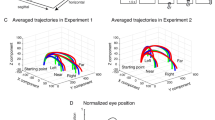Abstract
Reaching a target object requires accurate estimation of the object spatial position and its further transformation into a suitable arm-motor command. In this paper, we propose a framework that provides a robot with a capacity to represent its reachable space in an adaptive way. The location of the target is represented implicitly by both the gaze direction and the angles of arm joints. Two paired neural networks are used to compute the direct and inverse transformations between the arm position and the head position. These networks allow reaching the target either through a ballistic movement or through visually-guided actions. Thanks to the latter skill, the robot can adapt its sensorimotor transformations so as to reflect changes in its body configuration. The proposed framework was implemented on the NAO humanoid robot, and our experimental results provide evidences for its adaptative capabilities.
Access this chapter
Tax calculation will be finalised at checkout
Purchases are for personal use only
Preview
Unable to display preview. Download preview PDF.
Similar content being viewed by others
References
Antonelli, M., Chinellato, E., del Pobil, A.P.: Implicit mapping of the peripersonal space of a humanoid robot. In: IEEE Symposium on Computational Intelligence, Cognitive Algorithms, Mind, and Brain, pp. 1–8 (February 2011)
Caminiti, R., Ferraina, S., Mayer, A.B.: Visuomotor transformations: early cortical mechanisms of reaching. Current Opinion in Neurobiology 8(6), 753–761 (1998)
Chinellato, E., Antonelli, M., Grzyb, B., del Pobil, A.P.: Implicit sensorimotor mapping of the peripersonal space by gazing and reaching. IEEE Transactions on Autonomous Mental Development 3, 45–53 (2011)
Chinellato, E., del Pobil, A.P.: The neuroscience of vision-based grasping: a functional review for computational modeling and bio-inspired robotics. Journal of Integrative Neuroscience 8(2), 223–254 (2009)
Dechent, P., Frahm, J.: Characterization of the human visual V6 complex by functional magnetic resonance imaging. European Journal of Neuroscience 17(10), 2201–2211 (2003)
Fattori, P., Kutz, D., Breveglieri, R., Marzocchi, N., Galletti, C.: Spatial tuning of reaching activity in the medial parieto-occipital cortex (area V6A) of macaque monkey. European Journal of Neuroscience 22(4), 956–972 (2005)
Fuke, S., Ogino, M., Asada, M.: Acquisition of the head-centered peri-personal spatial representation found in vip neuron. IEEE Transactions on Autonomous Mental Development 1(2), 131–140 (2009)
Galletti, C., Kutz, D., Gamberini, M., Breveglieri, R., Fattori, P.: Role of the medial parieto-occipital cortex in the control of reaching and grasping movements. Experimental Brain Research 153(2), 158–170 (2003)
Goodale, M., Westwood, D.: An evolving view of duplex vision: separate but interacting cortical pathways for perception and action. Current Opinion in Neurobiology 14(2), 203–211 (2004)
Jones, M., Vernon, D.: Using neural networks to learn hand-eye co-ordination. Neural Computing and Applications 2(1), 2–12 (1994)
Karaoguz, C., Weisswange, T.H., Rodemann, T., Wrede, B., Rothkopf, C.A.: Reward-based learning of optimal cue integration in audio and visual depth estimation. In: The 15th International Conference on Advanced Robotics, Tallinn, Estonia (2011)
Karayiannis, N.B., Venetsanopoulos, A.N.: Fast learning algorithms for neural networks. IEEE Transactions on Circuits and Systems-II: Analog and Digital Signal Processing 39(7), 1–22 (1992)
Landy, M.S., Maloney, L.T., Johnston, E.B., Young, M.: Measurement and modeling of depth cue combination: in defense of weak fusion. Vision Research 35(3), 389–412 (1995)
Marjanovic, M., Scassellati, B., Williamson, M.: Self-taught visually guided pointing for a humanoid robot. In: From Animals to Animats 4: Proc. Fourth Int l Conf. Simulation of Adaptive Behavior, pp. 35—44 (1996)
Marzocchi, N., Breveglieri, R., Galletti, C., Fattori, P.: Reaching activity in parietal area V6A of macaque: eye influence on arm activity or retinocentric coding of reaching movements? European Journal of Neuroscience 27(3), 775–789 (2008)
Nori, F., Natale, L., Sandini, G., Metta, G.: Autonomous learning of 3d reaching in a humanoid robot. In: IEEE/RSJ IROS, International Conference on Intelligent Robots and Systems, pp. 1142–1147 (2007)
Park, J., Sandberg, I.W.: Universal approximation using radial-basis-function networks. Neural Comput. 3(2), 246–257 (1991)
Poggio, T., Girosi, F.: Regularization algorithms for learning that are equivalent to multilayer networks. Science 247(4945), 978–982 (1990)
Pouget, A., Sejnowski, T.J.: A new view of hemineglect based on the response properties of parietal neurones. Philosophical Transactions of the Royal Society B: Biological Sciences 352(1360), 1449–1459 (1997)
Salinas, E., Thier, P.: Gain modulation: a major computational principle of the central nervous system. Neuron 27(1), 15–21 (2000)
Sun, G., Scassellati, B.: A fast and efficient model for learning to reach. International Journal of Humanoid Robotics 2(4), 391–414 (2005)
Author information
Authors and Affiliations
Editor information
Editors and Affiliations
Rights and permissions
Copyright information
© 2012 Springer-Verlag Berlin Heidelberg
About this paper
Cite this paper
Antonelli, M., Grzyb, B.J., Castelló, V., del Pobil, A.P. (2012). Plastic Representation of the Reachable Space for a Humanoid Robot. In: Ziemke, T., Balkenius, C., Hallam, J. (eds) From Animals to Animats 12. SAB 2012. Lecture Notes in Computer Science(), vol 7426. Springer, Berlin, Heidelberg. https://doi.org/10.1007/978-3-642-33093-3_17
Download citation
DOI: https://doi.org/10.1007/978-3-642-33093-3_17
Publisher Name: Springer, Berlin, Heidelberg
Print ISBN: 978-3-642-33092-6
Online ISBN: 978-3-642-33093-3
eBook Packages: Computer ScienceComputer Science (R0)




